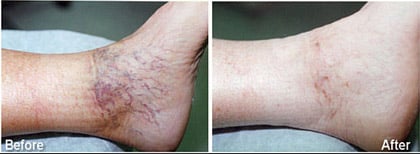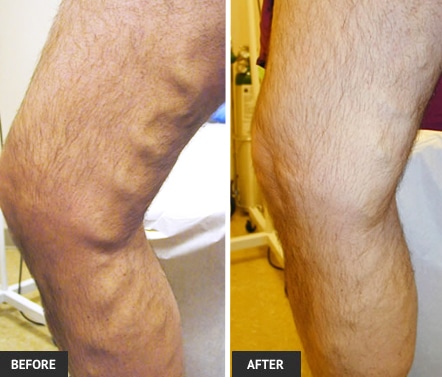When the goal is smooth, healthy, and more youthful-looking skin, there are a number of factors that can get in the way of achieving this aesthetic—particularly when it comes to the development of varicose or spider veins. Often accompanied by painful swelling, discoloration, and a webbing effect at the surface, both varicose and spider veins can be a frustrating development for men and women alike over time.

Just as important to recognize when it comes to these veins is that the results of their development are not only the visible features but underlying issues that could tell a wider-reaching story about an individual’s health profile. However, there are many treatments available to aleviate these issues; one in particular being foam sclerotherapy for spider veins.
What Causes Varicose and Spider Veins?
The human body requires a constant flow of freshly oxygenated blood to function properly and veins and arteries are part of the complex system charged with making sure blood is returned and distributed from the heart. Veins have the essential role of returning oxygen-depleted blood to the heart from far-reaching extremities which means working against the pull of gravity. One way valves within the veins help achieve this constant flow but in the event that valves malfunction, it doesn’t take long for blood to begin to flow the wrong direction and pool in place in the lower extremities. Often, this situation leads to the development of varicose veins that might bulge under the surface of the skin, present as twisted lengths of rope below the surface, and be accompanied by a variety of painful associated systems.

While less painful than varicose veins, the development of spider veins can be just as frustrating for patients on an aesthetic level. Spider veins often present as webs of blue, purple, or red on the skin and can develop anywhere on the body. While some spider veins are linked to excessive UV ray exposure, genetics or hormonal fluctuations, other spider veins occur when blood looks for a new route away from problematic varicose veins.
Treatment Options to Consider
Whatever the underlying cause for the development of varicose and spider veins may be, individuals looking to diminish or eliminate them today have plenty of options to do so. While cosmetic and medical services of the past often revolved around removing problematic veins through a painful process known as vein stripping, advances in technology and techniques make it easier than ever for patients to undergo procedures that are safe, effective, and minimally invasive at most.
Among the many options for treatment on the market, foam sclerotherapy for spider veins is finding its spot at the top of the list for those looking for a highly efficient route to reducing underlying vein issues while enjoying a quick to non-existent recovery time. This treatment is proving to be extremely effective at treating larger varicose veins as well as moderate spider veins across the body.
![Leg 14[1]](https://stlouislaserveins.com/wp-content/uploads/2025/08/Leg_141.png)
How Foam Sclerotherapy Works
Treatments begin with an attending physician clearly marking and mapping where problematic veins are on a patient. Once the mapping is complete, a local anesthetic is injected to ensure the procedure is painless for the patient. Over the course of 30 to 40 minutes, foam sclerosant will be injected through a small incision directly over the problematic vein. The foam sclerosant works to irritate the vein to the point of closure and collapse. Eventually, the vein is reabsorbed naturally by the body, allowing blood to circulate in a more constructive manner following healthy veins. One of the greatest benefits of foam versus liquid sclerotherapy is the foam’s ability to stick exclusively to the inside of the vein wall, ensuring there isn’t leakage into the surrounding blood flow or tissues.
Following foam sclerotherapy for spider veins, the vast majority of patients are recommended to wear a set of compression garments to promote healthy healing and blood flow for at least 24 to 48-hours. Pressure stockings are advisable for two weeks following treatment, however, all of these recommendations do not interfere with a patient’s ability to return to their everyday schedules and activities.
Safety Considerations
Foam sclerotherapy as a treatment option for varicose or spider veins is extremely safe. This outpatient procedure avoids the need for a lengthy hospital stay, use of general anesthesia, or a difficult recovery period where a patient would need to care for significant incisions or follow-up scarring.
Why is Foam Sclerotherapy a Good Treatment for Varicose Veins?
Foaming the sclerosant makes it more potent and makes the sclerosin expand into larger veins, and allows the sclerotherapy to treat large and tortuous veins better than any other treatment. The modern sclerosins are specialized detergents. Just like the foam from Dawn dish soap, these detergents create a foam to expand and treat bigger areas.
Ultrasound Guided Sclerotherapy for Spider Veins
Clear, smooth and youthful-looking skin is an understandable and relatable cosmetic goal for men and women across the map, but as time moves on and the natural aging process takes over, it can be more difficult to attain this standard in the long-term. While it may be easy to point to exterior factors such as sun damage as a primary culprit in skin looking less than its best, sometimes the true problem lies well below the surface.
The development and sudden appearance of spider veins on hands is a common complaint amongst individuals struggling to maintain healthy and smooth skin as they age. While the evidence of spider veins is very much at the surface of the skin, the cause often sits beyond what the naked eye can see. There are a variety of factors that are linked with the development of spider veins, but venous insufficiency is often a big one, and understanding what’s happening within the greater network of veins is a good route to understanding why ultrasound guided sclerotherapy might be best suited to eliminating spider veins at the source.
What Causes Spider Veins?
Many times, the development of spider veins is closely linked to the development of varicose veins deeper underneath the skin’s surface. Veins work hard to return oxygen-depleted blood back to the heart from the extremities where it’s been delivered by arteries. In order to do this against the force of gravity, it’s necessary for veins to be outfitted with a series of one-way valves. When these valves no longer work properly, blood quickly flows the opposite direction and begins to pool in the veins, causing eventual swelling, discoloration, and the probability of varicose veins in the long-term. With nowhere else to flow, blood begins to look for alternative circulatory routes. When blood branches off from problematic varicose veins, the result is frequently the development of nearby spider veins on hands.
Characteristics of Spider Veins
While spider veins don’t generally come with any associated or painful symptoms, many individuals desire to have them reduced or removed entirely in the name of cosmetic goals. Spider veins can appear anywhere on the body, including across the face, as a webbing of colorful damaged veins. While they are small in nature, spider veins can present in shades of blue, red, or even purple.
Treatment Options
While cosmetic surgeons of the past were very much limited in treating venous insufficiencies such as varicose and spider veins with invasive techniques such as vein stripping—patients today enjoy a wide variety of non-invasive or minimally invasive options when it comes to reducing and eliminating these issues. Amongst these options, ultrasound-guided sclerotherapy has become one of the best spider vein treatment options.. This technique is particularly helpful for those patients that may have underlying venous issues which, if caught early on, could prevent further development of both spider and varicose veins in the future.
How Ultrasound Guided Sclerotherapy Works
Patients that elect to undergo ultrasound guided sclerotherapy to treat spider veins begin with a traditional ultrasound procedure over the areas of the body where spider veins are dense or the physician believes there might be underlying problematic veins. The ultrasound allows the physician to both locate deeper-lying veins that need attention as well as guide the injection of either liquid or foam sclerosant directly into the veins in question. In reaction to the sclerosant, the vein spasms to the point of closure and collapse. Eventually, the vein is reabsorbed naturally into the body without causing harm to the surrounding veins or tissues. Ultimately, this leads to the fading and possible elimination of spider veins.
Safety Considerations
Ultrasound guided sclerotherapy is one of the best spider vein treatment options in large part thanks to its minimally invasive nature and quick recovery time. Results are proven to be highly effective and the procedure overall is considered extremely safe. Patients are not required to undergo general anesthesia when electing ultrasound-guided sclerotherapy, eliminating any of the risks also linked to a large surgery, long hospital stay or lengthy recovery period with significant wounds, stitches, and eventually scars to care for. Instead, this technique uses nothing more than a local anesthetic to keep a patient comfortable and the incision point is so minimal that stitches aren’t necessary and it’s unlikely that a scar will be visible.
Contact the St. Louis Laser Vein Center Today for Ultrasound Guided Sclerotherapy
Whether you’re looking to eliminate pre-existing spider veins, have concerns about potential venous insufficiencies or are simply looking to establish care regarding overall vein health, Dr. Wright and his team at the St. Louis Laser Vein Center are here to help. Contact us today to learn more about the many cosmetic services we offer or to schedule your initial consultation. With a dedication to comprehensive patient care an unwavering commitment to safety, patients who partner with us become part of the family from the moment they walk through the front door.
Dr. Wright Performing Ultrasound Sclerotherapy
Schedule a Consultation Today
There’s no reason to wait when you’re ready to learn more about the many options available when it comes to reducing or eliminating problematic varicose and spider veins. Reach out to Dr. Wright and his team at the St. Louis Laser Vein Center today to find out more about the services we offer as well as our practice of establishing care for long-term vein health. We’re dedicated to providing world-class service in a place where comprehensive patient care is always a top priority. Contact us for more information or to schedule your initial consultation.
